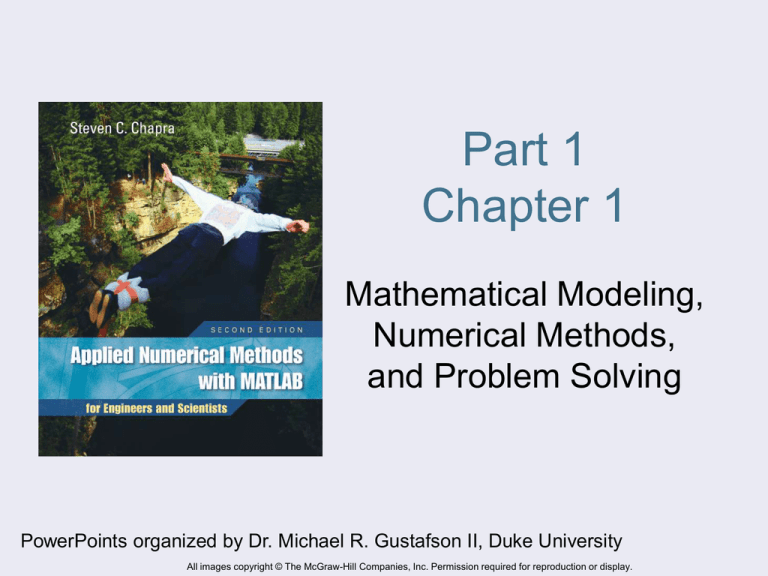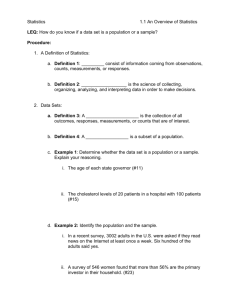Part 1 Chapter 1 Mathematical Modeling, Numerical Methods,
advertisement

Part 1 Chapter 1 Mathematical Modeling, Numerical Methods, and Problem Solving PowerPoints organized by Dr. Michael R. Gustafson II, Duke University All images copyright © The McGraw-Hill Companies, Inc. Permission required for reproduction or display. Chapter Objectives • Learning how mathematical models can be formulated on the basis of scientific principles to simulate the behavior of a simple physical system. • Understanding how numerical methods afford a means to generalize solutions in a manner that can be implemented on a digital computer. • Understanding the different types of conservation laws that lie beneath the models used in the various engineering disciplines and appreciating the difference between steadystate and dynamic solutions of these models. • Learning about the different types of numerical methods we will cover in this book. A Simple Mathematical Model • A mathematical model can be broadly defined as a formulation or equation that expresses the essential features of a physical system or process in mathematical terms. • Models can be represented by a functional relationship between dependent variables, independent variables, parameters, and forcing functions. Model Function Dependent variable independent f variables , parameters, forcing functions •Dependent variable - a characteristic that usually reflects the behavior or state of the system •Independent variables - dimensions, such as time and space, along which the system’s behavior is being determined •Parameters - constants reflective of the system’s properties or composition •Forcing functions - external influences acting upon the system Model Function Example • Assuming a bungee jumper is in midflight, an analytical model for the jumper’s velocity, accounting for drag, is v t gm cd tanh gc d t m • Dependent variable - velocity v • Independent variables - time t •Parameters - mass m, drag coefficient cd • Forcing function - gravitational acceleration g Model Results • Using a computer (or a calculator), the model can be used to generate a graphical representation of the system. For example, the graph below represents the velocity of a 68.1 kg jumper, assuming a drag coefficient of 0.25 kg/m Numerical Modeling • Some system models will be given as implicit functions or as differential equations - these can be solved either using analytical methods or numerical methods. • Example - the bungee jumper velocity equation from before is the analytical solution to the differential equation dv cd 2 g v dt m where the change in velocity is determined by the gravitational forces acting on the jumper versus the drag force. Numerical Methods • To solve the problem using a numerical method, note that the time rate of change of velocity can be approximated as: dv dt v t g cd m v ti 1 v ti ti 1 ti v (ti ) 2 Euler Method • Solve for vi+1 v i 1 v i d vi t dt • Known as “Euler’s method” • New value = old value + slope x step size • Will be discussed in detail in Chapter 20 Numerical Results • As shown in later chapters, the efficiency and accuracy of numerical methods will depend upon how the method is applied. • Applying the previous method in 2 s intervals yields: Bases for Numerical Models • Conservation laws provide the foundation for many model functions. • Different fields of engineering and science apply these laws to different paradigms within the field. • Among these laws are: – – – – Conservation of mass Conservation of momentum Conservation of charge Conservation of energy Summary of Numerical Methods • The book is divided into five categories of numerical methods:






